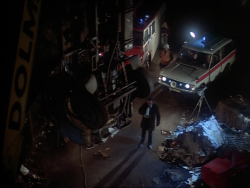by NEIL SINYARD
“Over the years Frears has refined a magical instinct for just how long we want to see a face and how long a scene needs to be. If he could bottle this instinct, it could be called “Essence of Moviemaking”.”- Pauline Kael1
Interviewer: “Would you say that your films show a concern for people living on society’s fringes?”
Stephen Frears: “It would never cross my mind, but now you come to mention it…”
The opening
 It is dead of night, and the sound of a crash is heard. Emerging out of the darkness, 11-year-old Leo (Richard Thomas) chances upon a scene of pure carnage, which, we will come to recognise, could stand as a symbolic representation of his vision of a broken-down grown-up world. A serious traffic accident has occurred, in which a lorry appears to have careered off a flyover and caused significant damage and serious injury below. The police, rescue workers and interested bystanders are already at the scene and getting in each other’s way. Amidst the chaos, no one pays much attention to the young boy moving between them or notice that Leo has spotted the cap of the chief inspector of police (Jack Douglas) on the back seat of his car and, while the inspector is otherwise occupied in trying to bring matters under control, has stolen it. When challenged about his presence on the scene, Leo has said he is on his way home; but, in fact, he pauses at the nearby police station and watches a young offender being roughly bundled out of a patrol car and taken inside. His curiosity being aroused, he stares in at the window as Inspector Ritchie (Derick O’Connor) is showing off the force’s new surveillance equipment. One of its monitors catches a glimpse of Leo.
It is dead of night, and the sound of a crash is heard. Emerging out of the darkness, 11-year-old Leo (Richard Thomas) chances upon a scene of pure carnage, which, we will come to recognise, could stand as a symbolic representation of his vision of a broken-down grown-up world. A serious traffic accident has occurred, in which a lorry appears to have careered off a flyover and caused significant damage and serious injury below. The police, rescue workers and interested bystanders are already at the scene and getting in each other’s way. Amidst the chaos, no one pays much attention to the young boy moving between them or notice that Leo has spotted the cap of the chief inspector of police (Jack Douglas) on the back seat of his car and, while the inspector is otherwise occupied in trying to bring matters under control, has stolen it. When challenged about his presence on the scene, Leo has said he is on his way home; but, in fact, he pauses at the nearby police station and watches a young offender being roughly bundled out of a patrol car and taken inside. His curiosity being aroused, he stares in at the window as Inspector Ritchie (Derick O’Connor) is showing off the force’s new surveillance equipment. One of its monitors catches a glimpse of Leo.
This opening is as striking for its style as its content. Although photographed by Chris Menges, who was the chief cameraman on Kes (1969), one could not mistake Bloody Kids for a Tony Garnett/Ken Loach social drama, for its look is lurid and garish and seems to be pushing the film beyond gritty realism. Stephen Frears was always looking for material that offered imaginative responses to the everyday, thus giving an overworked theme (in this case, juvenile delinquency) a fresh perspective and dimension. Visually Bloody Kids has something of the ambience of modern film noir, which will resurface in some of Frears’ later work, such as The Grifters (1990) and Dirty Pretty Things (2002). Some of his thematic preoccupations (to be discussed later) are being foreshadowed here also.
Pauline Kael, review of My Beautiful Laundrette, New Yorker, in Pauline Kael, Hooked (Marion Boyars, 1990). ↩
